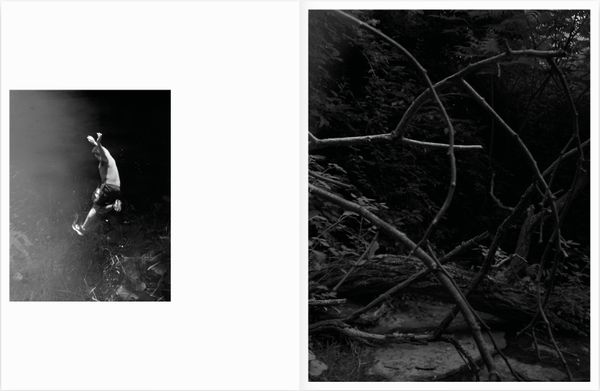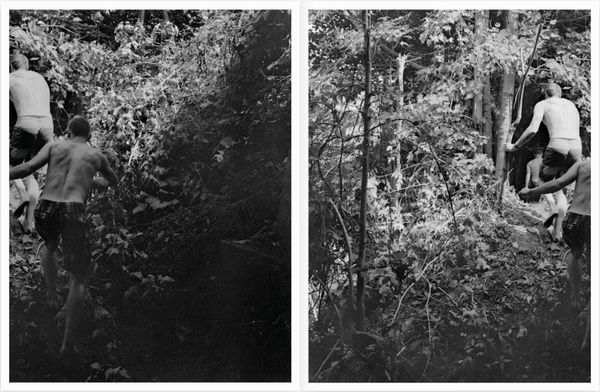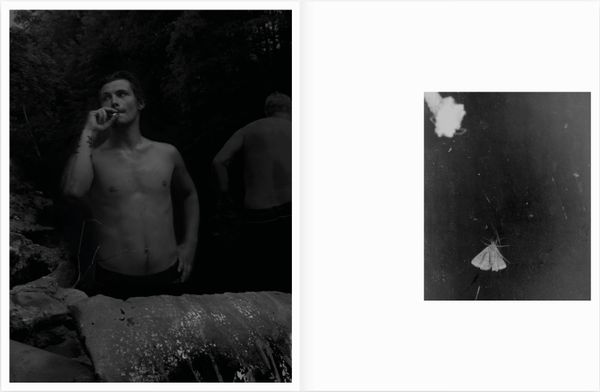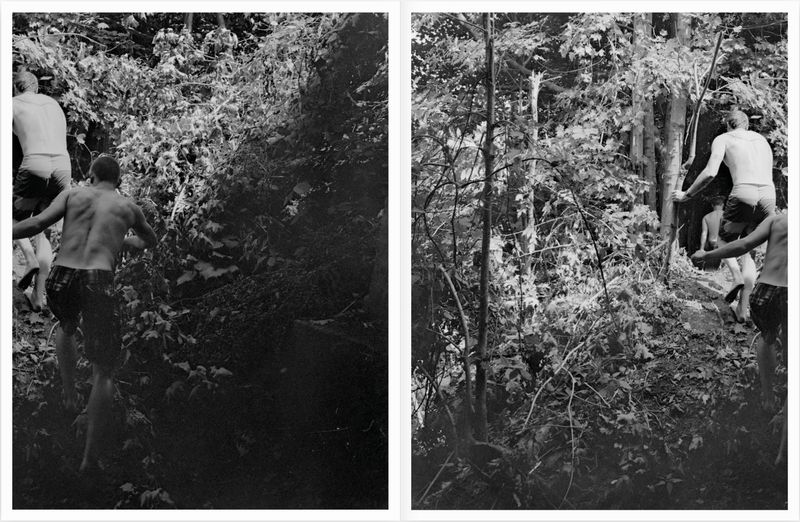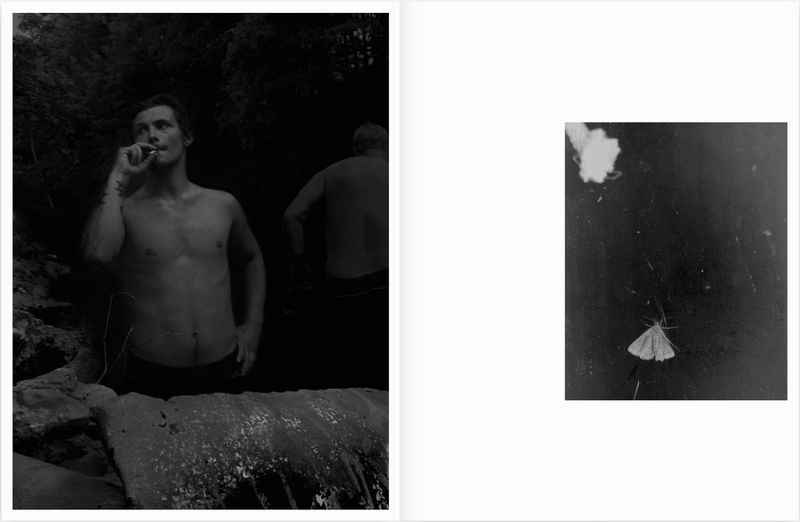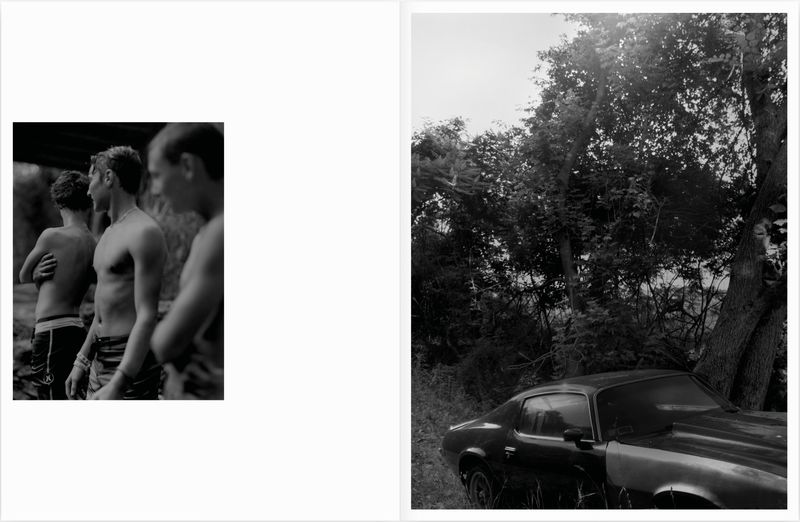Young, Male and American: Raymond Meeks’ Heart of Darkness
-
Published21 Sep 2018
-
Author
Halfstory Halflife by Raymond Meeks is a symbolic trip through the rites and rituals of American masculinity, through the American landscape, through American history and one of the books of the year.
Halfstory Halflife by Raymond Meeks is a symbolic trip through the rites and rituals of American masculinity, through the American landscape, through American history and one of the books of the year.
The first picture is of a bush on the roadway, the pale undersides of its leaves upturned by the dust-laden wind that is pummelling across the frame. Street lights and power cables rise in the background, a man-made counterpoint to the beating this roadside shrub is taking. It’s a quiet but astonishing picture, filled with a violence of movement that reaches beyond the frame.
T he next picture is of a young man, arms flailing, legs akimbo as he hurtles himself into the creek below. He’s shot from above, from the bridge that rises 60 feet over the water. It’s like one of Rodchenko’s divers but in reverse; instead of standing out against a mass of Rodchenkian white sky, this man is falling into a charcoal abyss, the faint outlines of the stone walls of the creek wall hastening his fall.
That’s how the book starts, and that’s how the book continues: in a flow of pictures that are beautiful but are not, that are concrete but are not, with a narrative that has a clear direction, but does not. Everything is up for grabs in Halfstory Halflife. The images fall one into another into a flow of masculinity where the modern world is left behind, where the rites and rituals of motorised American adolescence is parked on dusty lay-bys for the return to nature that the diving into the creek will provide.
The modern world with its cracked tarmac and dust-strewn concrete veneer is fragile in Halfstory Halflife. It’s fragmented, it’s transitory, it’s at the mercy of the trees and vines that line the roads and paths leading to the creek bed. And on those roads and paths you see male bodies, stripped to the waist as they walk into the darkness.
It’s Edenic, it’s ritualistic, and it’s threatening all at the same time. These young men (there are a handful of women in the book) walk along paths and throw themselves into the darkness of a nature that is far from benign. If it is Eden, it’s Eden after the Fall, which makes it a land where misogyny is written into the very soil. This is an American wilderness, half-Promised Land and Manifest Destiny, half Heart of Darkness. Fragments of grass stand in focus against blurred bodies, tightly wound torsos launching themselves into a dark unseen water. You never see the water in Halfstory Halflife.
When they get to the bottom of the creek, when they hit the pond (you never see them hitting the pond either), they go back to the top, walking barefoot up muddy pathways through avenues of birch and maple. The bodies are sweat-shined. With their long pants and bare backs these young men look like those you’d see in images from the war in Vietnam or the Pacific. But these young men aren’t in Vietnam, they’re not on Okinawa or Saipan, they’re in the United States in the 21st Century and if they are at war it is with America itself.
These men have their doubts. The arcadia becomes a setting for self-examination; a young man sits with his back to the photographer, hand on head, eyes cast down, searching for something in the darkness below. There are pictures of skin textured by the stone it’s been lying on, of flesh and creek merging through the overlay of rock, leaf and branch, through light and shade, through earth, wind and that consistently absent water.
There are young women and small boys in attendance at the creek, spectators for the masculinity that is performed through shows of leaping, diving, torquing and twisting. There’s chest-pumping bravado but also a sensitivity and delicacy that comes through these lean haunches of white flesh.
These are bodies that can be moulded, that are moulded by nature, that are joined by nature. But for all that physical unity, for all that shared space and joined experience, they are also people in and of themselves; there is muscle-toned posturing, there are alpha males but there is also shyness, thoughtfulness and uncertainty.
The boys in Halfstory Halflife live difficult lives. They live in a difficult world. And that’s how the book ends, with uncertainty, with a boy perched on the edge of a rock, about to launch himself but reluctant to do so, like one of the reluctant subjects of the Ten Metre Tower. Such is life and such is this book, a mysterious, beautiful contemplation of what it is to be young and male in a small corner of Upstate New York, in a small corner of anywhere.
--------------
Halfstory Halflife by Raymond Meeks
Photographs by Raymond Meeks // Design by Bureau Kayser // Published by Chose Commune
Softcover with flaps // 144 pages // 78 black and white photographs // 21.5 x 28 cm // €50
--------------
Raymond Meeks lives and works in the Hudson Valley, New York. He is the co-founder of Orchard Journal and Dumbsaint and the author of over 24 commercially and self-published books. His most recent collaborative journal, Township, was nominated for the 2018 International Photobook Award at Kassel. Meeks is represented by Wouter van Leeuwen in Amsterdam, Netherlands. Follow him on Instagram.
Colin Pantall is a photographer, writer and lecturer based in Bath, England. His latest book, All Quiet on the Home Front, focuses on family, fatherhood and the landscape. Follow him on Twitter and Instagram.
